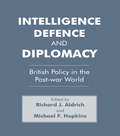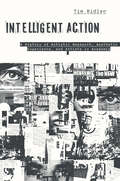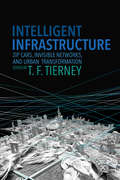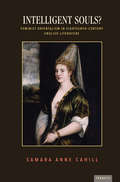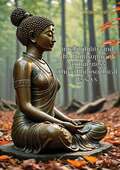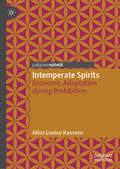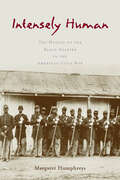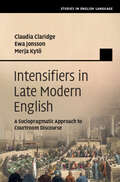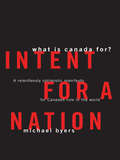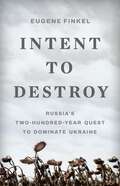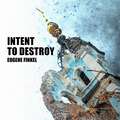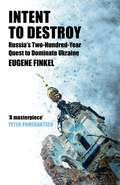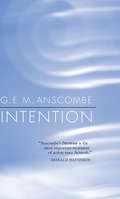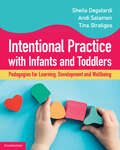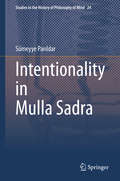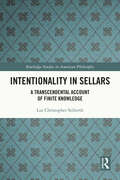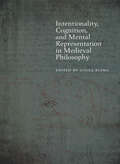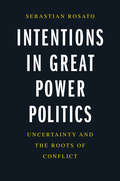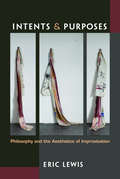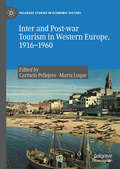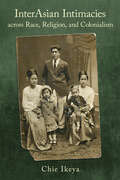- Table View
- List View
Intelligence, Defence and Diplomacy: British Policy in the Post-War World (Studies in Intelligence)
by Richard J. Aldrich Michael F. HopkinsWhat was Britain's reaction to the death of Stalin? How has Britain reconciled a modern nuclear strategy with its traditional imperial defence commitments around the world? How has secret intelligence affected the Special Relationship' since 1945? Certain clear questions and perennial themes run through British overseas policy since 1945. This book examines them, drawing on new research by leading historians and scholars in the field.
Intelligent Action: A History of Artistic Research, Aesthetic Experience, and Artists in Academia
by Timothy RidlenThrough archival research and analysis of artworks by Gyorgy Kepes, Allan Kaprow, Mel Bochner, and Suzanne Lacy, among others, Intelligent Action examines how these artists brought alternatives to dominant conceptions of research and knowledge production. The book is organized around specific institutional formations—artistic research centers, proposals, exhibitions on college campuses, and the establishment of new schools or pedagogic programs. Formal and social analysis demonstrate how artists responded to ideas of research, knowledge production, information, and pedagogy. Works discussed were produced between 1958 and 1975, a moment when boundaries between media were breaking down in response to technological, cultural, and generational change. In the context of academia, these artistic practices have taken up the look, feel, or language of various research and teaching practices. In some cases, artists bent to the demands of the cold war research university, while in others, artists developed new modes of practice and pedagogy. Reading these works through their institutional histories, author Tim Ridlem shows how artistic research practices and artistic subjectivity developed in the long 1960s within and alongside academia, transforming the role of artists in the process.
Intelligent Infrastructure: Zip Cars, Invisible Networks, and Urban Transformation
by T. F. TierneyWhile many of its traditional elements, such as roads and utilities, do not change, urban infrastructure is undergoing a fascinating and necessary transformation in the wake of new information and communication technologies. This volume brings together many of the most important new voices in the fields impacting modern urban infrastructure to explore this revolutionary change in the city. Increasingly, it is connective systems rather than built forms that bind a city together. Intelligent infrastructure confers upon a city previously unimagined levels of adaptability, with mobile telephony serving to organize people and events on the move and in real time. Beginning with a consideration of invisible networks--the sociohistorical systems that contribute to and constitute urbanity--the essays collected here examine a variety of actual tools, from handheld devices to autonomous vehicles, within a fully networked built environment: the smart city. This book argues that knowledge of both the visible and invisible components--information, energy, sustainability, transportation, housing, and social practices--are critical to understanding the urban environment. The dynamic and diverse cast of contributors includes Mitchell Schwarzer, Frederic Stout, Anthony Townsend, Carlo Ratti of the MIT SENSEable City Lab, Mitchell Joachim of Terreform ONE, and many other innovators who are changing the urban landscape.
Intelligent Souls?: Feminist Orientalism in Eighteenth-Century English Literature (Transits: Literature, Thought & Culture 1650-1850)
by Samara Anne CahillIntelligent Souls? offers a new understanding of Islam in eighteenth-century Britain. Samara A. Cahill explores two overlapping strands of thinking about women and Islam, which produce the phenomenon of “feminist orientalism.” One strand describes seventeenth-century ideas about the nature of the soul used to denigrate religio-political opponents. A second strand tracks the transference of these ideas to Islam during the Glorious Revolution and the Trinitarian controversy of the 1690s. The confluence of these discourses compounded if not wholly produced the stereotype that Islam denied women intelligent souls. Surprisingly, women writers of the period accepted the stereotype, but used it for their own purposes. Rowe, Carter, Lennox, More, and Wollstonecraft, Cahill argues, established common ground with men by leveraging the “otherness” identified with Islam to dispute British culture’s assumption that British women were lacking in intelligence, selfhood, or professional abilities. When Wollstonecraft wrote A Vindication of the Rights of Woman she accepted that view as true—and “feminist orientalism” was born, introducing a fallacy about Islam to the West that persists to this day. Published by Bucknell University Press. Distributed worldwide by Rutgers University Press.
Intelligibility and the Philosophy of Nothingness: Three Philosophical Essays (classic Reprint)
by Kitaro NishidaThese translations of Kitaro Nishida's philosophy of nothingness and the intelligible world are accompanied with a scholarly introduction that explains the author's ideas and views on Western philosophy.Prominent in intellectual circles in the early 20th century, Nishida did much to compare the traditional concepts of Eastern philosophy with the ideas prevalent in the West. Though concepts of Eastern thought range back many centuries, Japanese philosophy did not exist in the formal sense until the mid-19th century. Nishida and other prominent philosophers represented a flourishing of a field, their work building on older ideas prevalent in Japan.Considered both intriguing and refreshing by Western scholars, the work of Nishida and others was translated to other languages and received with interest in the West. For his part, Nishida held his Western forebears and contemporaries in high regard - opinions which earned him the contempt of the nationalist government of Japan during the era. Much of this book concerns his comments, comparisons and answers to Western philosophers like Kant and Goethe.-Print ed.
Intemperate Spirits: Economic Adaptation during Prohibition
by Alice Louise KassensUsing the basic economic principle of making decisions using a cost-benefit framework—and how changes in one or the other can result in a different decision—this book uncovers how various groups responded to incentives provided by the Prohibition legislation. Using this calculus, it is clear that even criminals are rational characters, responding to incentives and opportunities provided by the 18th Amendment and the Volstead Act. The book begins with a broad look at the adaptations of the law’s targets: the wine, beer, and liquor industries. It then turns to specific people (Violators, Line Tip-Toers, Enablers, and Hypocrites), sharing their stories of economic adaptation to bring economic lessons to life. Due to its structure, the book can be read in parts or as a whole and is suitable for short classroom reading assignments or individual pleasure reading.
Intensely Human: The Health of the Black Soldier in the American Civil War
by Margaret HumphreysBlack soldiers in the American Civil War were far more likely to die of disease than were white soldiers. In Intensely Human, historian Margaret Humphreys explores why this uneven mortality occurred and how it was interpreted at the time. In doing so, she uncovers the perspectives of mid-nineteenth-century physicians and others who were eager to implicate the so-called innate inferiority of the black body. In the archival collections of the U.S. Sanitary Commission, Humphreys found evidence that the high death rate among black soldiers resulted from malnourishment, inadequate shelter and clothing, inferior medical attention, and assignments to hazardous environments. While some observant physicians of the day attributed the black soldiers' high mortality rate to these circumstances, few medical professionals—on either side of the conflict—were prepared to challenge the "biological evidence" of white superiority. Humphreys shows how, despite sympathetic and responsible physicians' efforts to expose the truth, the stereotype of black biological inferiority prevailed during the war and after.
Intensely Human: The Health of the Black Soldier in the American Civil War
by Margaret HumphreysThis “informative” look at the causes of high mortality rates among black Civil War soldiers “gives readers some insight into current health disparities” (JAMA).Black soldiers in the American Civil War were far more likely to die of disease than were white soldiers. In Intensely Human, historian Margaret Humphreys explores why this uneven mortality occurred and how it was interpreted at the time. In doing so, she uncovers the perspectives of mid-nineteenth-century physicians and others who were eager to implicate the so-called innate inferiority of the black body.In the archival collections of the U.S. Sanitary Commission, Humphreys found evidence that the high death rate among black soldiers resulted from malnourishment, inadequate shelter and clothing, inferior medical attention, and assignments to hazardous environments.While some observant physicians of the day attributed the black soldiers’ high mortality rate to these circumstances, few medical professionals—on either side of the conflict—were prepared to challenge the “biological evidence” of white superiority. Humphreys shows how, despite sympathetic and responsible physicians’ efforts to expose the truth, the stereotype of black biological inferiority prevailed during the war and after.
Intensifiers in Late Modern English: A Sociopragmatic Approach to Courtroom Discourse (Studies in English Language)
by Claudia Claridge Ewa Jonsson Merja KytöThe development of intensifiers has long been identified as an area of vibrant change in Late Modern English. This groundbreaking book provides the first comprehensive study of intensifiers in this period, and shows how they have changed over time. It uses speech-based and interactive data from the Old Bailey courthouse in London, enriched by extralinguistic information in the Old Bailey Corpus, to investigate an unprecedented range of intensifiers, including downtoners, boosters, and maximizers. The courtroom acts as a social microcosm of the period, providing unique insights on gender, class, and courtroom roles, and their effects on language use. The usage of intensifiers is illuminated from a lexico-grammatical angle, focusing on their formal and semantic features, as well as those of the items they modify. These perspectives are linked to temporal developments from 1720 to 1913, to offer a complete picture of variation and change in the intensifier area.
Intent For A Nation: What is Canada For
by Michael ByersIn Intent for a Nation, Michael Byers argues that it is time for a clear-eyed appreciation of our strengths and weaknesses, of all we have and all we could be. A whole series of world events-the waning of US credibility; the increasing value of natural resources; the brain-gain; the ever-increasing interdependence of peoples, countries and continents-have combined to put Canada center stage in a new world order. Instead of emulating our increasingly isolated neighbor, we should be advancing the Canadian model, an idealistic, fiscally prudent, socially progressive vision that has never looked so good.Intent for a Nation is a fundamentally optimistic, informed and opinionated overview of where Canada stands in the world and what aggressive public policies are needed to carry the country forward in an ever more competitive and volatile world.Here is a book urging Canadians to rediscover their national self-confidence, to find the courage to dream great dreams-and make them happen.
Intent to Destroy: Russia's Two-Hundred-Year Quest to Dominate Ukraine
by Eugene FinkelWritten with &“erudition and verve&” (Timothy Snyder, New York Times-bestselling author of On Tyranny), this is the full story of how and why Russia has tried to violently subjugate Ukraine across the centuries, and how Ukrainians have resisted Russia&’s brutal invasion of Ukraine in February 2022 shocked the world. And yet, to Ukrainians, this attack was painfully familiar, the latest episode in a centuries-long Russian campaign to divide and oppress Ukraine. In Intent to Destroy, political scientist Eugene Finkel uncovers these deep roots of the Russo-Ukrainian War. Ukraine is a key borderland between Russia and the West, and, following the rise of Russian nationalism in the nineteenth century, dominating Ukraine became the cornerstone of Russian policy. Russia has long used genocidal tactics—killings, deportations, starvation, and cultural destruction—to successfully crush Ukrainian efforts to chart an independent path. As Finkel shows, today&’s violence is simply a more extreme version of the Kremlin&’s long-standing policy. But unlike in the past, the people of Ukraine—motivated by the rise of democracy in their nation—have overcome their deep internal divisions. For the first time, they have united in favor of independence from Russia. Whatever the outcome of the present war, Ukraine&’s staunch resistance has permanently altered its relationship to Russia and the West. Intent to Destroy offers the vital context we need to truly understand Europe&’s bloodiest conflict since World War II.
Intent to Destroy: Russia's Two-Hundred-Year Quest to Dominate Ukraine
by Eugene Finkel'The must read masterpiece . . . utterly essential' PETER POMERANTSEV'With erudition and verve' TIMOTHY SNYDER'Powerful' SERHII PLOKHY'Masterful' BEN ANSELLA history of Russian violence waged against Ukraine across the centuries. Russia's brutal invasion of Ukraine in February 2022 shocked the world. And yet this attack was in fact the latest episode in a centuries-long Russian campaign. In Intent to Destroy, leading scholar of genocide and Eastern Europe Eugene Finkel uncovers the deep roots of the Russo-Ukrainian War. Ever since the rise of Russian nationalism in the nineteenth century, the domination of this key borderland has become a cornerstone of Russian and Soviet policy. Using genocidal tactics - killings, deportations, starvation and cultural destruction - against ethnic Ukrainians and minorities including Tatars, Jews and Poles, Russia's long-standing policy has aimed to obliterate Ukrainian identity. This eradication has consistently been a part of the Kremlin playbook and leads inexorably to the violence we see today. Told with the astonishing power of Finkel's connection to this living history, and the authority of two decades of research, Intent to Destroy casts today's war it its broadest historical context, illuminating as never before Europe's bloodiest conflict since World War II.
Intent to Destroy: Russia's Two-Hundred-Year Quest to Dominate Ukraine
by Eugene Finkel'The must read masterpiece . . . utterly essential' PETER POMERANTSEV'With erudition and verve' TIMOTHY SNYDER'Powerful' SERHII PLOKHY'Masterful' BEN ANSELLA history of Russian violence waged against Ukraine across the centuries. Russia's brutal invasion of Ukraine in February 2022 shocked the world. And yet this attack was in fact the latest episode in a centuries-long Russian campaign. In Intent to Destroy, leading scholar of genocide and Eastern Europe Eugene Finkel uncovers the deep roots of the Russo-Ukrainian War. Ever since the rise of Russian nationalism in the nineteenth century, the domination of this key borderland has become a cornerstone of Russian and Soviet policy. Using genocidal tactics - killings, deportations, starvation and cultural destruction - against ethnic Ukrainians and minorities including Tatars, Jews and Poles, Russia's long-standing policy has aimed to obliterate Ukrainian identity. This eradication has consistently been a part of the Kremlin playbook and leads inexorably to the violence we see today. Told with the astonishing power of Finkel's connection to this living history, and the authority of two decades of research, Intent to Destroy casts today's war it its broadest historical context, illuminating as never before Europe's bloodiest conflict since World War II.
Intent to Destroy: Russia's Two-Hundred-Year Quest to Dominate Ukraine
by Eugene Finkel'The must read masterpiece . . . utterly essential' PETER POMERANTSEV'With erudition and verve' TIMOTHY SNYDER'Powerful' SERHII PLOKHY'Masterful' BEN ANSELLA history of Russian violence waged against Ukraine across the centuries. Russia's brutal invasion of Ukraine in February 2022 shocked the world. And yet this attack was in fact the latest episode in a centuries-long Russian campaign. In Intent to Destroy, leading scholar of genocide and Eastern Europe Eugene Finkel uncovers the deep roots of the Russo-Ukrainian War. Ever since the rise of Russian nationalism in the nineteenth century, the domination of this key borderland has become a cornerstone of Russian and Soviet policy. Using genocidal tactics - killings, deportations, starvation and cultural destruction - against ethnic Ukrainians and minorities including Tatars, Jews and Poles, Russia's long-standing policy has aimed to obliterate Ukrainian identity. This eradication has consistently been a part of the Kremlin playbook and leads inexorably to the violence we see today. Told with the astonishing power of Finkel's connection to this living history, and the authority of two decades of research, Intent to Destroy casts today's war it its broadest historical context, illuminating as never before Europe's bloodiest conflict since World War II.
Intention
by G. E. AnscombeIntention is one of the masterworks of twentieth-century philosophy in English. First published in 1957, it has acquired the status of a modern philosophical classic. The book attempts to show in detail that the natural and widely accepted picture of what we mean by an intention gives rise to insoluble problems and must be abandoned. This is a welcome reprint of a book that continues to grow in importance.
Intentional Practice with Infants and Toddlers: Pedagogies for Learning, Development and Wellbeing
by Sheila Degotardi Andi Salamon Tina StratigosChildren in their first three years of life learn, develop and grow at a faster rate than at any other time, with early childhood teachers and educators playing a vital role in providing them with the very best learning opportunities. Intentional Practice with Infants and Toddlers focuses on purposeful pedagogical approaches, equipping pre-service and practising early childhood teachers and educators with the professional knowledge and strategies required to implement effective infant and toddler pedagogies in early childhood education settings. Drawing on a growing body of research and evidence, the book covers topics such as educational programs, pedagogy as care, health and physical wellbeing, creating a language-rich environment, establishing social cultures, and documenting, planning for and communicating learning. Features include spotlight boxes to explore relevant research, theories and practices; vignettes to open each chapter; reflection questions; and links to the Early Years Learning Framework and National Quality Standards.
Intentionality in Mulla Sadra (Studies in the History of Philosophy of Mind #24)
by Sümeyye ParıldarThis volume translates Brentano’s intentionality into medieval psychological and ontological discussions through Sadrian theories of sense perception and mental existence. Applying a new methodology, it reframes various parts of Sadrian theory around the problem of intentionality, which results in a refreshed reading of the philosopher Mulla Sadra. The book starts out by defining intentionality problem and discussing the historiography of Brentano’s conceptualization. It examines immateriality, content and aboutness, and sense perception. In its conclusion, the book claims that intentionality in Mulla Sadra combines ontological and psychological realities and that as a result of Sadrian monism, the intentionality, intentional object, the agent, and the reality are different versions of same reality.
Intentionality in Sellars: A Transcendental Account of Finite Knowledge (Routledge Studies in American Philosophy)
by Luz Christopher SeiberthThis book argues that Sellars’ theory of intentionality can be understood as an advancement of a transcendental philosophical approach. It shows how Sellars develops his theory of intentionality through his engagement with the theoretical philosophy of Immanuel Kant. The book delivers a provocative reinterpretation of one of the most problematic and controversial concepts of Sellars' philosophy: the picturing-relation. Sellars' theory of intentionality addresses the question of how to reconcile two aspects that seem opposed: the non-relational theory of intellectual and linguistic content and a causal-transcendental theory of representation inspired by the philosophy of the early Wittgenstein. The author explains how both parts cohere in a transcendental account of finite knowledge. He claims that this can only be achieved by reading Sellars as committed to a transcendental methodology inspired by Kant. In a final step, he brings his interpretation to bear on the contemporary metaphilosophical debate on pragmatism and expressivism. Intentionality in Sellars will be of interest to scholars of Sellars and Kant, as well as researchers working in philosophy of mind, epistemology, and the history of nineteenth- and twentieth-century philosophy.
Intentionality, Cognition, and Mental Representation in Medieval Philosophy (Medieval Philosophy: Texts and Studies)
by Gyula KlimaIt is commonly supposed that certain elements of medieval philosophy are uncharacteristically preserved in modern philosophical thought through the idea that mental phenomena are distinguished from physical phenomena by their intentionality, their intrinsic directedness toward some object. The many exceptions to this presumption, however, threaten its viability. This volume explores the intricacies and varieties of the conceptual relationships medieval thinkers developed among intentionality, cognition, and mental representation. Ranging from Aquinas, Scotus, Ockham, and Buridan through less-familiar writers, the collection sheds new light on the various strands that run between medieval and modern thought and bring us to a number of fundamental questions in the philosophy of mind as it is conceived today.
Intentions Scandaleuses
by Amanda Mariel Margarete CoutoFaisant face à la perte de l’appui de son père, le fameux libertin Monsieur Julian Luvington décida faire la cour à Mademoiselle Sarah. Elle est aussi respectable que possible, comme l’exige son père. Mais la jeune fille n’est pas aussi maniable que d’autres. Mademoiselle Sarah Roseington est déterminée à se marier par amour ou pas du tout, et elle fera son possible pour avoir autant de liberté que celle offerte aux hommes. L’infâme Lord Luvington pourrait détruire sa réputation, mais se marier avec avait aussi certains avantages, il lui offrait des opportunités qu’elle ne pourrait atteindre para elle-même. Que fera la jeune femme ? Quand Monsieur Lord Luvington refuses de cesser de lui faire la cour, Mademoiselle Sarah proposes un accord. Seulement le prix pourrait être trop élevé. Mademoiselle Sarah pourrait y perdre plus que son statut social et Julian pourrait y perdre son cœur.
Intentions in Great Power Politics: Uncertainty and the Roots of Conflict
by Sebastian RosatoWhy the future of great power politics is likely to resemble its dismal past Can great powers be confident that their peers have benign intentions? States that trust each other can live at peace; those that mistrust each other are doomed to compete for arms and allies and may even go to war. Sebastian Rosato explains that states routinely lack the kind of information they need to be convinced that their rivals mean them no harm. Even in cases that supposedly involved mutual trust—Germany and Russia in the Bismarck era; Britain and the United States during the great rapprochement; France and Germany, and Japan and the United States in the early interwar period; and the Soviet Union and United States at the end of the Cold War—the protagonists mistrusted each other and struggled for advantage. Rosato argues that the ramifications of his argument for U.S.–China relations are profound: the future of great power politics is likely to resemble its dismal past.
Intentions scandaleuses: -
by Amanda MarielMadame Sarah veut la liberté accordée aux hommes, mais son seul espoir est un escroc notoire qui veut à tout prix conserver le soutien de son père. Lorsqu'il doit perdre le soutien de son père, Lord Julian Luvington, un escroc notoire, jette son dévolu sur Madame Sarah. Elle est tout ce qu'il y a de plus respectable, exactement ce que son père a ordonné. Mais la dame ne se laissera pas facilement à conquérir. Madame Sarah Roseington est déterminée à se marier par amour ou pas du tout, et elle est prête à tout pour obtenir la liberté accordée aux hommes. Un garde-chiourme comme Seigneur Luvington pourrait détruire la réputation qu'elle a durement acquise, mais son mariage avec lui lui offre également des opportunités qu'elle ne peut atteindre seule. Que peut faire une Dame ? Lorsque Seingeur Luvington refuse d'abandonner sa poursuite, Madame Sarah propose un arrangement. Mais le prix à payer risque d'être plus élevé que ce qu'ils avaient prévu. Madame Sarah pourrait perdre plus que son statut social et Julian pourrait perdre son cœur.
Intents and Purposes: Philosophy and the Aesthetics of Improvisation
by Eric LewisHow do we define improvised music? What is the relationship of highly improvised performances to the work they are performances of? How do we decide what are the important parts of an improvised musical work? In Intents and Purposes, Eric Lewis uses a series of case studies to challenge assumptions about what defines a musical work and musical performance, seeking to go beyond philosophical and aesthetic templates from Western classical music to foreground the distinctive practices and aesthetics of jazz. Pushing aside the assumption that composition and improvisation are different (or even opposed) musical practices, Lewis’s philosophically informed approach revisits key topics in musical ontology, such as how to define the triangle of composer-performer-listener, and the status of live performances in relation to scores and recordings. Drawing on critical race theory, feminist theory, new musicology, sociology, cognitive science, and genre theory, Lewis opens up new questions about agency in performance, as well as new ways of considering the historical relationships between improvisational practices with roots in different cultural frameworks. By showing how jazz can be both art, idea, and action all at the same time, Lewis offers a new way of seeing any improvised musical performance in a new culturally and aesthetically rich context.
Inter and Post-war Tourism in Western Europe, 1916–1960 (Palgrave Studies in Economic History)
by Carmelo Pellejero Martínez Marta Luque ArandaThis edited collection is a novel book with contributions from eleven expert researchers on the history of tourism in Europe. This book explores the growth of tourism in contemporary postwar Europe, especially during the periods following the First and Second World Wars and the Spanish Civil War. It reveals both the work carried out by social agents and institutions to develop tourism, and the contribution of tourism in boosting the economy and the recovery of morale in the Old Continent Its origin is the International Congress Postguerres / Aftermaths of War, organized by the Department of History and Archeology of the University of Barcelona, in Barcelona, in June 2019. In this Congress, professors Carmelo Pellejero and Marta Luque coordinated the session Post-war and tourism in contemporary Europe, in which all the authors of the book participated.
InterAsian Intimacies across Race, Religion, and Colonialism
by Chie IkeyaIn InterAsian Intimacies across Race, Religion, and Colonialism, Chie Ikeya asks how interAsian marriage, conversion, and collaboration in Burma under British colonial rule became the subject of political agitation, legislative activism, and collective violence. Over the course of the twentieth century relations between Burmese Muslims, Sino-Burmese, Indo-Burmese, and other mixed families and communities became flashpoints for far-reaching legal reforms and Buddhist revivalist, feminist, and nationalist campaigns aimed at consigning minority Asians to subordinate status and regulating women's conjugal and reproductive choices. Out of these efforts emerged understandings of religion, race, and nation that continue to vex Burma and its neighbors today.Combining multilingual archival research with family history and intergenerational storytelling, Ikeya highlights how the people targeted by such movements made and remade their lives under the shifting circumstances of colonialism, capitalism, and nationalism. The book illuminates a history of belonging across boundaries, a history that has been overshadowed by Eurocentric narratives about the mixing of white colonial masters and native mistresses. InterAsian intimacy was—and remains—foundational to modern regimes of knowledge, power, and desire throughout Asia.
